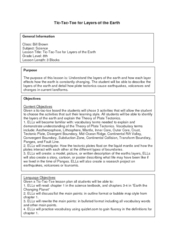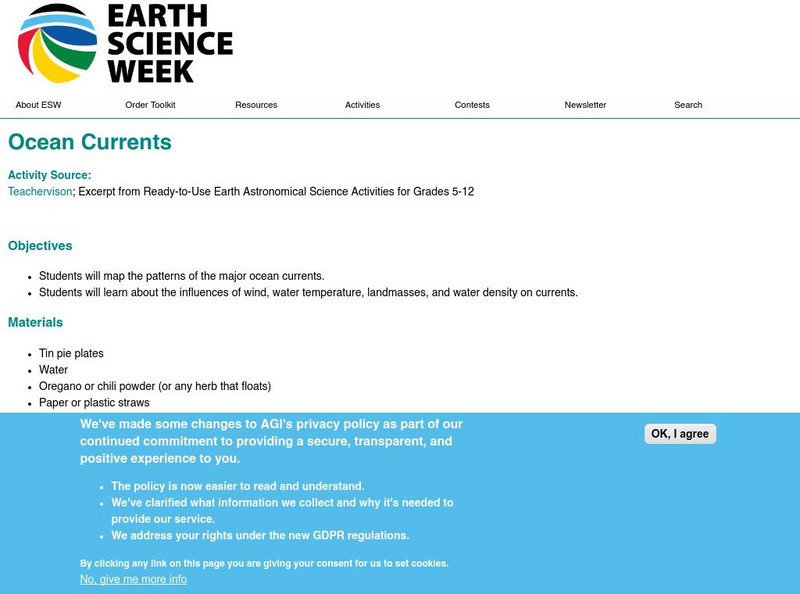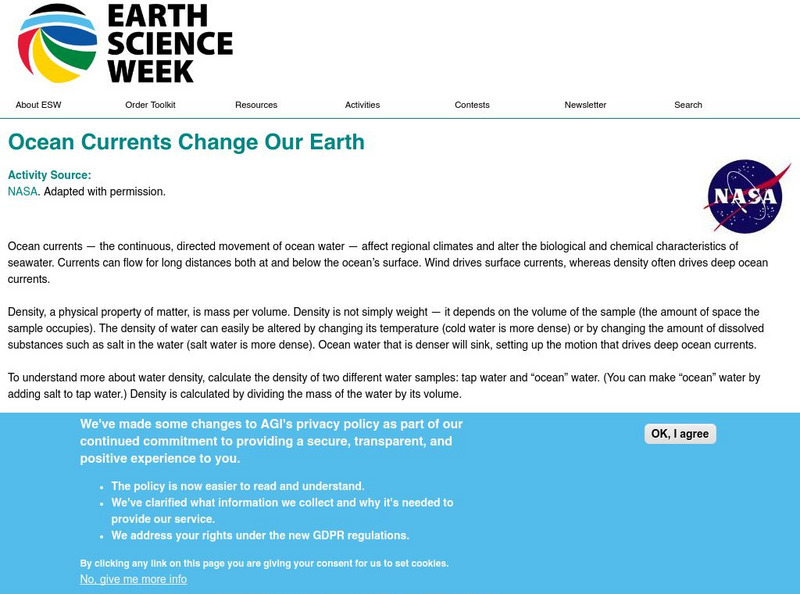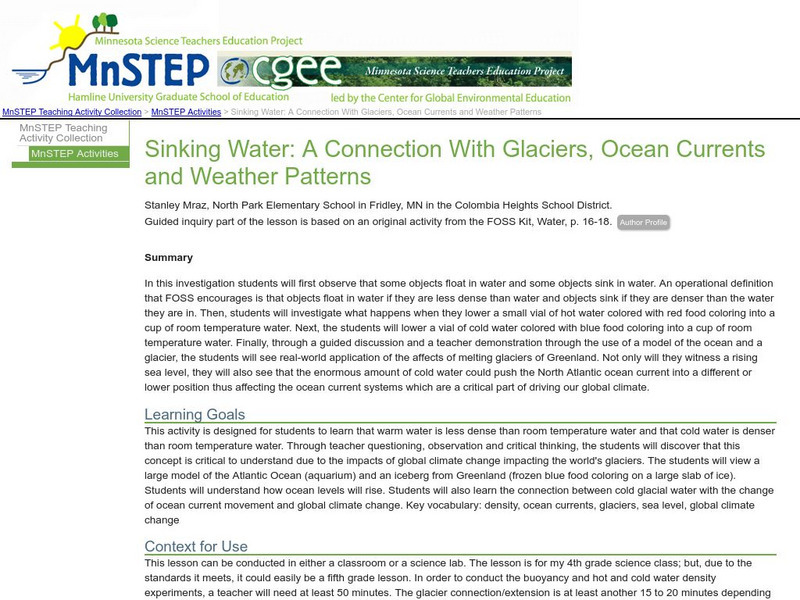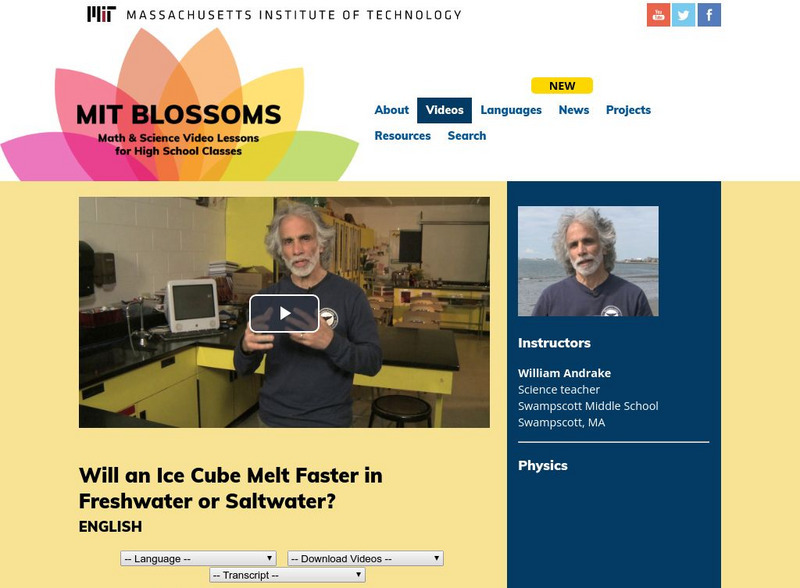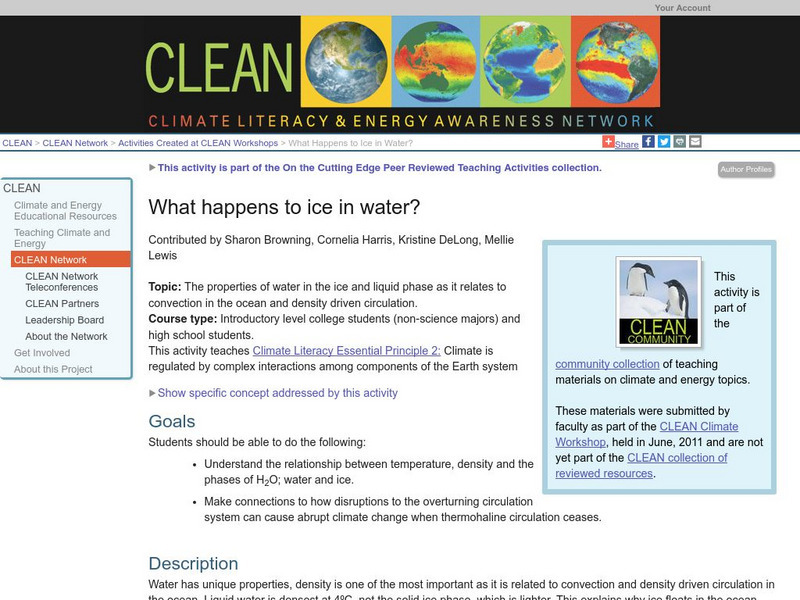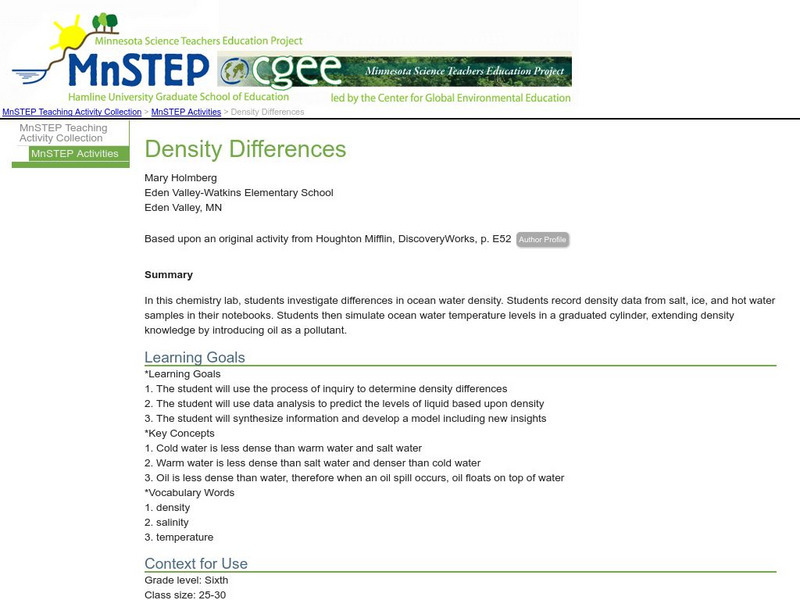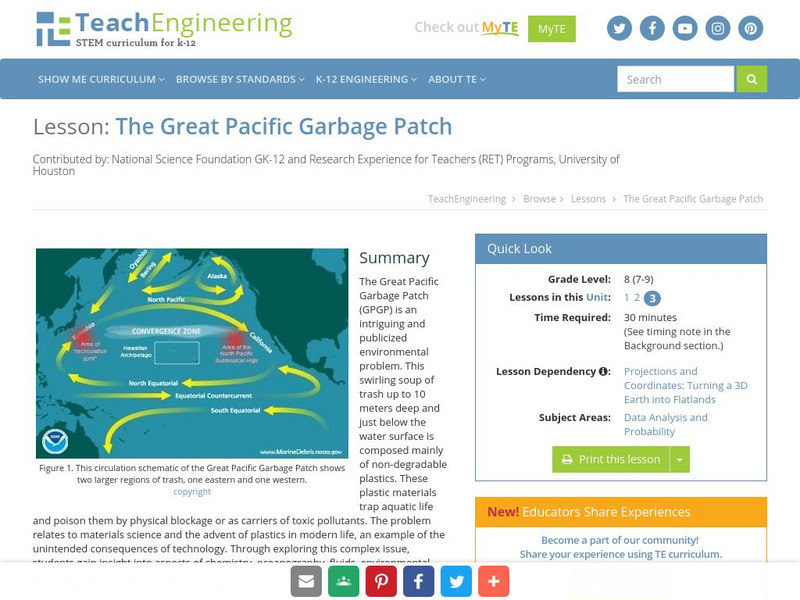Curated OER
Deep Sea Fishing for Facts
Third graders read each question and click on the Web link located next to it. They find the answer to the question and type in their answer below the questions. When finished, they print off their page and turn it in.
Curated OER
Musical Plates
Sixth graders engage in a study of the plates and how they are part of the formation of the ever changing landscape of planet earth. They access web sites that have applications for observation and conducting different activities. The...
Curated OER
Jeannette
Students develop hypothesis about what might happen when salt water is frozen. In groups, they freeze ice samples with different salt concentrations. They use the internet to research the situation of the Jeannette to discover their...
Curated OER
Harmful Algal Blooms in Full Bloom
Students calculate the total percentage of samples from the data on the graphs. In this marine science lesson, students analyze the concentration levels over a period of time. They suggest ways to lessen the effect of these blooms.
Curated OER
Tic-Tac-Toe for Layers of the Earth
Eighth graders identify the different layers of the earth. In this earth science lesson, 8th graders choose a project to do from a given list according to their learning style. They present their finished project in class.
Curated OER
Hudson Canyon Expedition Let's Bet on Sediments!
Students investigate and analyze the patterns of sedimentation in the Hudson Canyon students observe how heavier particles sink faster than finer particles. They study that submarine landslides (trench slope failure) are
Curated OER
John Fitch: Pioneer Steamboat Inventor
Students explore the transportation revolution brought about through the use of steam power to move boats over water. They practice note taking skills by taking notes from an article.
American Geosciences Institute
American Geosciences Institute: Earth Science Week: Ocean Currents
Students map the patterns of the major ocean currents, and learn about the influences of wind, water temperature, landmasses, and water density on currents.
American Geosciences Institute
American Geosciences Institute: Earth Science Week: Ocean Currents Change Our Earth
Middle schoolers learn about the factors that drive ocean currents by measuring the density of ocean water and tap water.
Climate Literacy
Clean: Ocean Currents and Sea Surface Temperature
To discover the link between ocean temperatures and currents as related to our concern for current climate change.
NOAA
Noaa: Ocean Explorer: Hot, Cold, Fresh and Salty
Students simulate ocean water characteristics in order to recognize that the effects of salinity and temperature are the drivers of thermohaline circulation.
Science Education Resource Center at Carleton College
Serc: Mn Step: Sinking Water: Glaciers, Ocean Currents and Weather Patterns
A lesson where students learn how warm water is less dense than cold water, and what this means for global climate change as ice from the polar regions melts. Students will do experiments in buoyancy and water density when hot or cold,...
Other
Art Gallery of Nova Scotia: The Inside Current
This is a lesson plan for Grade 8 that focuses on ocean currents and wind patterns. Part of it looks at the lessons learned from studying the flow of the rubber ducks accidentally dumped into the north Pacific Ocean in 1992.
Climate Literacy
Clean: Ocean Impacts on an El Nino Event
Students examine the relationships among sea surface height, sea surface temperature, and wind vectors in classifying the ocean characteristics of an El Nino.
Other
Ocean Tracks: Fact or Artifact? Interpreting Patterns in Ocean Tracks Data [Pdf]
Ever wonder where marine animals go? How fast they swim? How deep they dive? Electronic tagging has opened a new window into the world of the open ocean. Ocean Tracks gives you access to data collected by tags on real live migrating...
Texas A&M University
Texas A&m University: Properties of the Ocean Activities
This site is from the Texas A&M University provides a lesson plan on measurement and properties of the ocean. As part of the instructional activity students are challenged to create a model of an underwater amusement park. Web...
Climate Literacy
Clean: Global Ocean Conveyor Belt
This hands-on activity explores the driving forces behind global thermohaline circulation.
Other
Nanoos: Well, Well, Well [Pdf]
This lesson provides students the opportunity to investigate the relationship between winds, surface currents, sea temperature and upwelling and downwelling off the coast of Oregon and Washington.
Massachusetts Institute of Technology
Mit: Blossoms: Will an Ice Cube Melt Faster in Freshwater or Saltwater?
Engage young scholars in the study of the ocean and saltwater with these activities. Students will see that saltwater has different physical properties than freshwater - mainly density. This instructional activity can serve as a...
Climate Literacy
Clean: What Happens to Ice in Water?
Students investigate the properties of water in the ice and liquid phase as it relates to convection in the ocean and density driven circulation, and ultimately the climate.
Science Education Resource Center at Carleton College
Serc: Density Differences
Students investigate differences in ocean water density, and record density data from salt, ice, and hot water samples in their notebooks. Students then simulate ocean water temperature levels in a simulation.
Science Education Resource Center at Carleton College
Serc: Chesapeake Interactive Modeling Project
Understand the basic characteristics of circulation in the Chesapeake Bay, by allowing students to change the wind speed and velocity, and the freshwater forcing through a number of subestuaries, and observe the resulting surface height,...
TeachEngineering
Teach Engineering: The Great Pacific Garbage Patch
The Great Pacific Garbage Patch (GPGP) is an interesting and somewhat publicized environmental problem. A swirling soup of trash up to 10 meters deep and just below the water surface is composed mainly of non-degradable plastics. These...
Science Education Resource Center at Carleton College
Serc: Earthlabs: Corals Unit Overview
Six lab investigations on corals expose students to some of the most current scientific research, data, and visualizations in a way that allows them to become active participants in both learning about and conserving coral reefs.
Other popular searches
- Worksheets Ocean Currents
- Deep Ocean Currents
- Ocean Currents Pdf
- Ocean Currents and Climate
- Dangerous Ocean Currents
- Ocean Currents Climate
- Ocean Currents Events
- Ocean Currents Grade 11
- Weather Ocean Currents
- Madagascar Ocean Currents
- Measuring Ocean Currents
- Ocean Currents Pd




